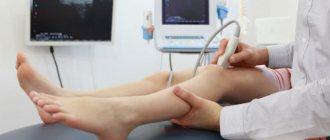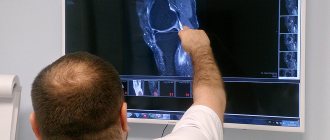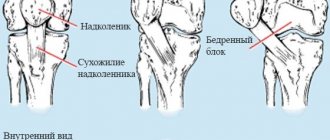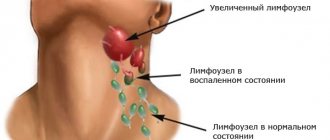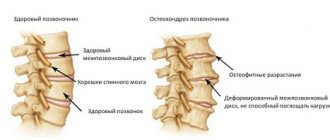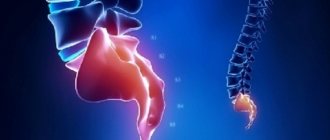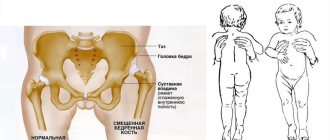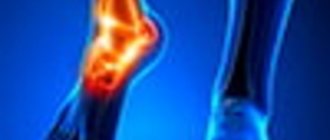Menu
+38
Menu
Useful information
Author of the article
Abramova Antonina Yurievna
Artem Naumenko
This article was written together with Artem Naumenko, the chief physician of the MedinUA clinic. 14 years of experience Contact a doctor
Swelling of the knee and ankle
characterized by inflammation of soft tissues. The process is accompanied by redness and swelling, pain and discomfort. The violation requires immediate medical intervention. If you have swelling, the MedinUa clinic will provide the necessary assistance. The treatment method is determined depending on the cause and extent of the problem.
Causes of swelling of the knee and ankle
Before starting treatment, it is necessary to clearly determine the causes of pain and swelling in the legs below the knee. Therefore, you should not self-medicate - it is better to immediately consult a specialist.
Swelling below the knee to varying degrees can occur for a number of reasons:
- Severe fatigue;
- Pregnancy - swelling is possible in the last months;
- Accumulation of fluid in the legs in the summer;
- Allergies are a common cause of edema. An allergen can be anything: medications, insect bites, food, etc.
- Infection is infection by bacteria acquired after an injury or various viruses.
- Psoriasis is a skin disease often associated with psoriatic arthritis.
- Gout is a disease that is caused by stagnation of uric acid in the joint. Causes swelling and pain while walking.
- Arthritis – wear and further ossification of cartilage tissue. The disease often occurs in older people and is accompanied by swelling.
- Arthrosis – due to deformation and inflammation, synovial fluid leaks out of the joint, which causes swelling.
- Rheumatoid arthritis is a soft tissue disease caused by dysfunction of the immune system.
- Peripheral edema - caused by poor circulation.
- Bursitis and synovitis are diseases that also cause the accumulation of synovial fluid.
Common causes of swelling in the knee area are osteoarthritis, meniscus cyst, and osteochondritis dissecans. To accurately determine the type of disease, it is necessary to undergo an examination by a doctor and a number of additional studies.
What are the causes of hemarthrosis
Most often, the disease results from a bruise, dislocation or subluxation, rupture of a ligament or meniscus. Trauma leads to damage to the blood vessel - blood enters the cavity. This happens, for example, when falling while skating or skateboarding, if the athlete does not use knee pads, as well as in everyday life - even when going down the stairs unsuccessfully.
Very rarely, the cause of hemarthrosis is a blood disease, such as hemophilia or hemorrhagic diathesis, as well as other coagulation pathologies.
Symptoms
Depending on the source of the problem, the swelling process may manifest itself in the following signs:
- If the cause of swelling is gout or arthritis, then the swelling is accompanied by pain in the joint and nearby muscles.
- Psoriatic arthritis can be recognized not only by swelling, but also by red spots that appear throughout the body. Also, the skin often becomes covered with scales, and the joints on the fingers of the limbs swell.
- Septic arthritis is accompanied not only by swelling, but also by fever.
- Bursitis reveals itself not only by swelling, but also by redness. Often the skin becomes hot to the touch and pain occurs.
- If the cause of pain is injury, then the pain syndrome will manifest itself not only during movement, but also in a calm state.
First aid
If the knee is swollen without bruising and is very painful, then you must immediately make an appointment with an orthopedist to determine the cause of the pathological condition. Doctors do not recommend that patients take analgesics, NSAIDs, diuretics, or use anti-inflammatory ointments or gels before consultation. This significantly distorts the clinical picture and complicates diagnosis. It is advisable to improve well-being in case of acute pain syndrome or in the absence of the possibility of quickly seeing a doctor. What to do in such cases:
- lie down, avoid any static or dynamic loads;
- elevate the sore leg by placing it on a bolster or pillow;
- for severe pain, take a tablet of Nise, Ketorol, Ibuprofen.
Cold compresses are used to eliminate swelling. Fill a plastic bag with crushed ice, wrap it in thick cloth, and apply it to the sore joint for 10 minutes. The procedure should be performed every hour until the swelling resolves. Orthopedists recommend applying a bandage to the knee by wrapping an elastic bandage around it several times. The joint should not be overly compressed - this will only increase the severity of swelling due to pinching of the blood vessels.
Ice compress.
Treatment of swelling of the ankle and knee joint
If the cause of leg swelling is normal fatigue or fluid accumulation in the summer, standard home procedures will be sufficient: a cool shower and bed rest with your legs elevated. You can apply a cold compress to the site of swelling, and also use special ointments to relieve inflammation.
If these simple steps do not help relieve swelling, consult a doctor immediately. The specialist will conduct an examination, analyze your complaints and medical history. Additional research may be needed (blood test, urine test, etc.). After a detailed examination, the doctor will determine the true cause of the swelling.
If you have serious diseases (arthritis or, for example, arthrosis), the doctor will definitely prescribe anti-inflammatory drugs. Depending on the type of problem, the following treatment methods are used:
- physiotherapy;
- physiotherapy;
- diet;
- immobilization;
- drug treatment.
If you approach the problem comprehensively, conservative treatment will give results. But it is worth remembering that edema is not a disease, but only its manifestation. If the disease is associated with joint dysfunction and is in a severe stage, sometimes the best solution is surgery. With the help of surgical operations, specialists can restore the integrity of joints, remove accumulated fluid, eliminate pathological growths, etc. Eradicating the problem is the guarantee that swelling will not appear again after some time.
A well-designed treatment regimen will eliminate the disorder in the shortest possible time. The duration of treatment depends entirely on the cause of the swelling and the individual characteristics of the patient.
Subtleties of diagnosis
Often, an external examination is sufficient to diagnose hemarthrosis. The doctor will palpate and make sure that the patella is balling. Such a “floating” patella is never detected with ordinary bruises.
A puncture of the knee joint will help confirm the presence of blood in the cavity, but it is not enough to understand the nature of the damage. Therefore, patients are prescribed additional examination - MRI, CT or ultrasound.
How does blood get into the joint capsule? Expert - about the mechanism of development of hemarthrosis:
Treatment of edema at the MedinUa medical center
If you want to get professional medical care in Dnepr, contact the Clinic of Progressive Orthopedics and Traumatology named after. Academician Loskutov. Unlike ordinary government agencies, we provide European-style services. For us, every patient is a family member who needs our support.
Advantages of the center Academician Loskutov:
- affordable prices;
- sterile cleanliness and comfortable rooms;
- availability of a laboratory on the clinic premises;
- use of modern treatment methods (conservative and surgical);
- operating rehabilitation department;
- refund of the cost of treatment if you are not satisfied with the result;
- guarantee of confidentiality of each patient;
- the latest equipment for diagnosis, treatment and rehabilitation.
In addition, only experienced specialists work at the MedinUa clinic. All the chief doctors of the center studied and worked abroad in clinics in Europe and the USA. Be confident in our professionalism - contact the center named after. Loskutova right now!
Important! The article was written based on the recommendations of doctors related to this profile.
Sign up for a consultation
Treatment tactics for hemarthrosis
First of all, it is necessary to quickly remove blood and synovial fluid from the cavity through puncture. The procedure is carried out under local anesthesia under aseptic conditions, after which special drugs are administered orally - anti-inflammatory, analgesic and hemostatic. Sometimes, as in the treatment of osteoarthritis of the knee, arthroscopy may be necessary if the damage to the internal structures is large.
If the blood volume is less than 20-30 ml, you can do without a puncture: the clots will gradually dissolve on their own. If the manipulation is carried out, the patient is given a pressure bandage, and the joint is immobilized using a plaster or splint. For a week, it is recommended to use crutches to walk so as not to rely on the affected leg. At the end of this period, as in the treatment of arthrosis, rehabilitation measures are indicated - physiotherapy, massage and exercise therapy.
The doctor will decide whether a puncture is necessary. It all depends on the volume of blood in the joint cavity
Specialists of the direction
Artem Naumenko
Expert in the treatment of knee injuries and back pain. Work experience 14 years
Oleg Loskutov
President of the Association of Foot Surgery, expert in the field of foot surgery and endoprosthetics. Work experience 14 years
Artem Naumenko
Expert in the treatment of knee injuries and back pain. Work experience 13 years
Oleg Loskutov
President of the Association of Foot Surgery, expert in the field of foot surgery and endoprosthetics. Work experience 14 years
What to do if your knee is swollen and painful?
Almost all diseases and injuries of the knee joint are accompanied by the development of swelling and inflammation of the soft tissues. If your knee is swollen and it hurts, there can be many reasons.
Possible causes of swelling and pain
- Damage to knee ligaments. When a knee ligament is torn, sprained, or otherwise damaged, it becomes noticeably swollen, causing severe sharp pain and a feeling of instability. For example, if the anterior cruciate ligament is damaged, severe pain and instability of the joint will not allow you to step on the affected leg, and it will be almost impossible to walk.
- Inflammation of the tendons - tendinitis. Tendons are thick, dense fibers of connective tissue that attach muscles to bones. When they are irritated, inflamed or damaged, the knee swells, and sharp pain appears in the joint when walking, running or rotating movements.
- Inflammation of the joint capsule (bursitis) leads to inflammation, pronounced swelling and redness of the soft tissue around the knee joint. When bending the leg, severe pain occurs.
- Displacement of the kneecap is accompanied by swelling, discomfort, and difficulty walking. When straightening the leg, the pain intensifies, sometimes it is not possible to straighten the leg completely.
- A knee joint injury is accompanied by swelling, redness and pain when moving.
- Rheumatoid arthritis is a debilitating chronic disease in which the knee can be constantly swollen and painful with any movement, especially in the morning.
- Osteoporosis is accompanied by swelling and pain of varying severity, and discomfort occurs when moving the joint. Often the pain is weather-dependent (intensifies before any weather changes).
- Septic arthritis is accompanied by swelling, redness, pain, and sometimes fever.
- With gout, the knee hurts, swells, redness appears, and suddenly there is severe pain that lasts for several days and then subsides.
As you can see, there are many reasons for the appearance of swelling and pain in the knee, and it is impossible to independently determine why they arose in your particular case. To do this, you should seek medical help.
Diagnostic methods and treatment
After examining the sore knee, the doctor may prescribe an X-ray, computed tomography (CT) scan, or MRI. If infection is possible, a blood test will be required. In some cases, to clarify the diagnosis, a joint puncture is performed: through a small puncture, a sample of blood or intra-articular fluid is taken for analysis.
Treatment will depend entirely on the diagnosis.
First aid
If you feel severe discomfort and intense pain in your knee, you can try to relieve these symptoms before seeing a doctor. Here are quick home treatment methods:
- Give your knee a rest and try, if possible, not to put any strain on your sore leg.
- Apply ice to the joint for 15–20 minutes to reduce swelling and pain. If you don’t have ice on hand, you can use any item from the freezer (a bag of frozen dumplings or a piece of frozen meat will do).
- Compress made from tincture of horse chestnut flowers. For 50 g of flowers, take 500 ml of vodka, leave the mixture in a glass container for a week in a cool, dry place, then rub the knee at night or when the pain intensifies.
- A compress of a mixture of iodine, camphor, medical alcohol (taken in a ratio of 1:1:1) and 10 analgin tablets. Dissolve analgin in a mixture of alcohols and iodine, make a compress on the sore knee. Leave for about 30 minutes, then, when the pain subsides, gently rinse with warm water and walk for a while.
If you managed to relieve the pain for a while, this is not a reason to postpone your visit to the doctor. Don’t wait for complications, try to solve the problem right away!
Risk factors
Each of us can get a knee injury or get arthritis, but there are categories of people who are always at risk:
- Overweight people. Excess weight significantly increases the load on the knees even during normal walking, which can cause the joints to become deformed and destroyed.
- People whose activities involve high physical activity, for example, athletes.
- In women after 40 years of age, the risk of developing osteoporosis increases significantly, and in general, representatives of the weaker sex are more prone to rupture of knee ligaments than men.
- People who lead a sedentary lifestyle and have a lack of muscle flexibility. Such muscles support the knee joint worse and do not smooth out the load on it.
- People with certain anatomical features, such as flat feet or legs of different lengths.
If you know that you are at risk, try not to put excessive stress on your knees without good reason. Overweight people should think about adjusting their lifestyle and diet, because excess weight affects not only the joints, but also the heart, blood vessels and other internal organs. And don’t take your health lightly— pain and swelling in your knee should be a reason to see a doctor as soon as possible.
Source sustavzdorov.ru
